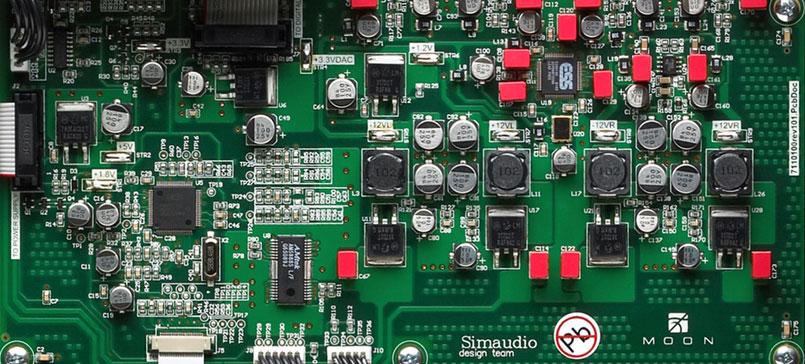USB, coaxial or Redbook?
As expected for an upper echelon product like the 750D, it has a variety of inputs allowing for flexibility in establishing one’s system. As Redbook playback seems to wane with each passing year, file playback through USB is picking up momentum. The presence of the Moon DAC in my home allowed me to compare sound quality between my default, Net-based playback source for the past two years, the Sonos Digital Music System, and a PC laptop with Windows 7 running iTunes or J River Media software feeding the 750D.
Sonos has been a lovely product for our family (Why am I speaking in the past tense? Perhaps I have upgradeitis.), and a competent performer for my listening room. For some time now I have used its SPDIF/Digital Coaxial output to an outboard DAC to improve sound quality. The Sonos desktop control panel on my laptop in my listening room is fed wirelessly from a wireless bridge connected to my office computer’s hub. A Sonos ZP80 unit in the audio room snags the signal and sends it out via SPDIF/Digital Coaxial cable to an external DAC. Alternatively, the Moon 750D’s USB playback originates from the home computer and is secured via a wireless signal sent from the home computer’s router to the listening room laptop. From there a file is played back through iTunes or J River software, sent to the 750D through a USB cable. Note that in both cases there is a wireless signal being utilized.
The two systems looked thus in terms of getting the signal to the designated input at the rear of the Moon 750D:
USB: Home computer to router to iTunes or J River software on listening room Laptop to Moon 750D to Pathos Classic One MkIII Integrated Amps in Mono configuration to Legacy Audio Whisper DSW speakers
SPDIF (Digital Coaxial): Home computer to network router to Sonos Bridge to listening room Laptop’s Sonos Desktop Control Panel to Sonos ZP80 unit to Moon 750D to Pathos Classic One MkIII amps to Legacy Audio Whisper DSW speakers
In essence, the difference between these two systems were the software systems employed to secure and disseminate the Net-based music files (I played back both systems using the same files), the cables between the DAC and source signal, and the signal path inside the 750D. I used a 16-foot DH Labs Silver Sonic USB cable and a Clarity Cable Organic Digital cable for all the trials.
My goal was to compare my best Redbook playback to the best from Sonos and USB. I started with Sonos and broke with my “looney-tuned” music since I needed a hard copy as well as files of any test track on either Sonos or iTunes/J River. Here I will discuss two of the pieces of music I compared between these three playback modes: Toto’s “I’ll Be Over You,” and Adele’s “Turning Tables.”
Sonos sounded good because it was first; anything can sound pretty good when it’s auditioned first. This reminds me of the Tim Tebow story from his book Through My Eyes where he relates how he has always been driven to win. Once as a teen he entered a men’s weight curling competition where the goal was to curl a 55-pound bar for maximum reps. Some men ahead of him reached forty, or even fifty repetitions, which – trust me – is very good. Tebow kept slipping to the back of the line to learn the number he had to beat. When it was his turn he cranked out a bicep-binding 315 repetitions! He states succinctly, “I won,” but couldn’t extend his arms for two days. I guess so!
While you might think that here I would go on to say that the second contender, USB, hung back then stepped up to humiliate the Sonos playback, you would be wrong. It would be fair to say that in some respects the USB was superior, while in others it lagged. Initially playing through the USB input, the iTunes software was markedly inferior to the Sonos. iTunes sounded flatly two-dimensional, uninspiring tonally and lacking in precision across the spectrum. Only when I upgraded the software in service to the J River Media Center did the Sonos and the USB from the laptop become comparable. Still, “I’ll Be Over You” was lacking much of the air and reverberation which is easily heard on the compact disc.
Also, on Adele’s “Turning Tables” the USB playback was leaner, with a more immediate but not so deep soundstage, and average definition but of not-so-pristine character. I began to become irritated with the sibilance in Adele’s voice listening by USB. In comparison, the Sonos-fed coaxial playback was warmer and less indistinct, but not much better overall. The Sonos system faulted slightly on the opposite end of the spectrum, capturing the weight of the 750D and warmness far better than USB but rolling off the high-end slightly. Compared to the best CD playback these both fell short, but not by such a large margin that an audiophile would not be able to listen to them casually.
Redbook was still the best. In this test, there was no beating the bits with the shortest signal path to the 750D’s internal DAC. In comparison, both the USB input fed by J River file playback and Sonos’ coaxial digital to the 750D failed to trump the good old’ CD! This did not really surprise me, as previous informal tests of Sonos showed that CD was better. I wondered if in this case USB would stand taller than CD. It did not. Perhaps I need a Mac Mini and/or Sonic Studio’s Amarra software, or a USB cable made of Unobtainium. The day may come in my system when USB slaughters all other formats, but not in this particular comparison. Do not forget that the 750D’s internal-processing a CD is 32-bit, being upsampled to both interpolate beyond 24-bit players for better microdynamics and definition, but also escaping an additional component, namely the laptop or Sonos unit and linking cable. Those are sizable potentially deleterious factors to overcome in the Sonos and USB sourced scenarios. However, good news is on the horizon for purchasers of the 750D. As of January 1, 2012, the Moon 750D will be shipped with 24-bit/192kHz processing for the USB input, which will apply all its appealing sound to Hi-Rez files.
What this test showed me was that USB is on the upswing. Likely, with more extreme measures it would walk right past the Sonos as a source. I can understand how some have found far superior sound through file playback to CD playback. But in my rig now, Redbook is still slightly ahead. I plan to delve further into playback using systems with a USB-linked front-end, which might tip the playing field solidly in favor of the file versus the disc.
The bright side of the Moon
The silver orb adorning our night sky moves through phases, showing us at times a sliver of its face, and at other times an unblushing frontal stare. Unlike the Sun which blinds when we peer at it, the moon is amenable to endless gawking. In the reflected light of the sun we can make out what appear to be fine features on the Moon’s surface. Were we to magnify that surface greatly, its fissures and jaggedness would reveal itself to be far more hostile.
The illumination of the audio signal emanating from within the Moon 750D is similar; it does not blind with brilliance in an attempt to overwhelm in terms of tonality or detail, and as such it is not torturous on the ears. Rather, it casts a luminous sound clear enough to make out details but not so harsh that one must turn away if the music is unrefined, or the listening level extreme. It leaves nothing unsaid while saying everything in an understated manner. It’s a fine choice as “the romanticists DAC/player.”
- ← Previous page
- (Page 4 of 4)



